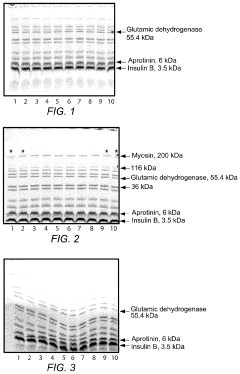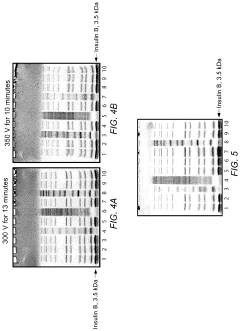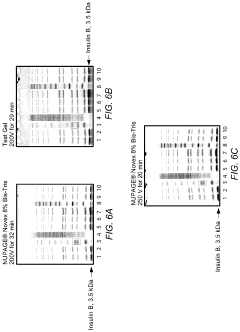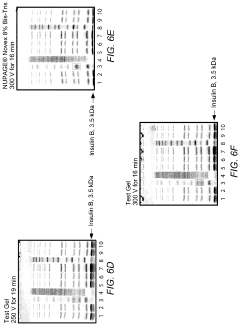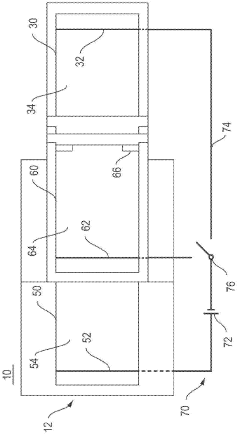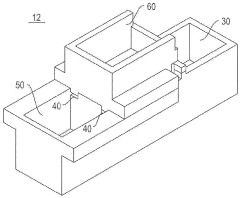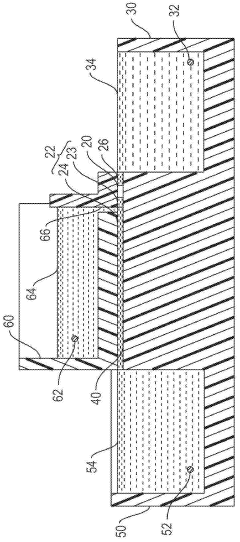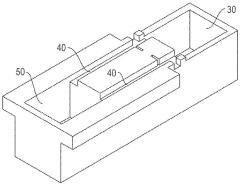Enhancing Accuracy in Gel Electrophoresis: Tips & Tricks
JUN 30, 20259 MIN READ
Generate Your Research Report Instantly with AI Agent
Patsnap Eureka helps you evaluate technical feasibility & market potential.
Gel Electrophoresis Evolution and Objectives
Gel electrophoresis has evolved significantly since its inception in the 1930s, becoming a cornerstone technique in molecular biology and biochemistry. Initially developed for protein separation, it has since expanded to encompass nucleic acid analysis, playing a crucial role in various scientific disciplines.
The evolution of gel electrophoresis can be traced through several key milestones. In the 1950s, the introduction of polyacrylamide gels revolutionized protein separation, offering superior resolution compared to earlier starch gels. The 1970s saw the advent of agarose gel electrophoresis for DNA analysis, which became instrumental in the genomic era. Subsequent decades brought refinements in gel composition, buffer systems, and detection methods, enhancing the technique's versatility and sensitivity.
Recent advancements have focused on improving accuracy, reproducibility, and throughput. The development of pulsed-field gel electrophoresis (PFGE) in the 1980s enabled the separation of large DNA molecules, expanding the technique's applications. Digital imaging systems and fluorescent dyes have replaced traditional staining methods, allowing for more precise quantification and analysis of separated molecules.
The primary objective of gel electrophoresis in modern research and diagnostics is to achieve high-resolution separation of biomolecules with maximum accuracy and reproducibility. This goal encompasses several specific aims:
1. Enhancing separation resolution to distinguish closely related molecules.
2. Improving detection sensitivity to analyze low-abundance samples.
3. Increasing throughput for high-volume applications.
4. Ensuring reproducibility across different laboratories and experimental conditions.
To address these objectives, researchers are exploring various strategies. These include the development of novel gel matrices with tailored pore sizes, optimization of buffer systems for specific applications, and integration of advanced detection technologies. Additionally, there is a growing emphasis on standardization of protocols and the use of internal standards to improve inter-laboratory comparability.
The future of gel electrophoresis lies in its integration with other analytical techniques and its adaptation to emerging fields such as proteomics and metabolomics. As the demand for more precise and high-throughput molecular analysis grows, gel electrophoresis continues to evolve, maintaining its relevance in the ever-expanding landscape of biological research and diagnostic applications.
The evolution of gel electrophoresis can be traced through several key milestones. In the 1950s, the introduction of polyacrylamide gels revolutionized protein separation, offering superior resolution compared to earlier starch gels. The 1970s saw the advent of agarose gel electrophoresis for DNA analysis, which became instrumental in the genomic era. Subsequent decades brought refinements in gel composition, buffer systems, and detection methods, enhancing the technique's versatility and sensitivity.
Recent advancements have focused on improving accuracy, reproducibility, and throughput. The development of pulsed-field gel electrophoresis (PFGE) in the 1980s enabled the separation of large DNA molecules, expanding the technique's applications. Digital imaging systems and fluorescent dyes have replaced traditional staining methods, allowing for more precise quantification and analysis of separated molecules.
The primary objective of gel electrophoresis in modern research and diagnostics is to achieve high-resolution separation of biomolecules with maximum accuracy and reproducibility. This goal encompasses several specific aims:
1. Enhancing separation resolution to distinguish closely related molecules.
2. Improving detection sensitivity to analyze low-abundance samples.
3. Increasing throughput for high-volume applications.
4. Ensuring reproducibility across different laboratories and experimental conditions.
To address these objectives, researchers are exploring various strategies. These include the development of novel gel matrices with tailored pore sizes, optimization of buffer systems for specific applications, and integration of advanced detection technologies. Additionally, there is a growing emphasis on standardization of protocols and the use of internal standards to improve inter-laboratory comparability.
The future of gel electrophoresis lies in its integration with other analytical techniques and its adaptation to emerging fields such as proteomics and metabolomics. As the demand for more precise and high-throughput molecular analysis grows, gel electrophoresis continues to evolve, maintaining its relevance in the ever-expanding landscape of biological research and diagnostic applications.
Market Demand for Precise Molecular Separation
The demand for precise molecular separation techniques has been steadily increasing across various scientific and industrial sectors. Gel electrophoresis, a fundamental method in molecular biology, plays a crucial role in this field. The market for accurate gel electrophoresis solutions is driven by the growing need for reliable DNA and protein analysis in research, diagnostics, and forensics.
In the research sector, academic institutions and biotechnology companies require high-precision gel electrophoresis for a wide range of applications, including gene expression studies, protein characterization, and genetic engineering. The increasing complexity of research projects and the push for reproducible results have heightened the demand for more accurate and consistent separation techniques.
The diagnostics industry represents a significant market for precise molecular separation. With the rise of personalized medicine and molecular diagnostics, there is a growing need for accurate DNA and protein analysis in clinical settings. Gel electrophoresis plays a vital role in genetic testing, disease diagnosis, and monitoring treatment efficacy. The demand for point-of-care diagnostic devices that incorporate precise electrophoresis techniques is also on the rise.
Forensic science is another field driving the demand for accurate gel electrophoresis. DNA profiling and analysis of biological evidence require highly precise separation techniques to ensure reliable results in criminal investigations and legal proceedings. The increasing use of DNA evidence in courtrooms has led to a greater emphasis on the accuracy and reliability of molecular separation methods.
The pharmaceutical and biotechnology industries also contribute significantly to the market demand for precise molecular separation. Drug discovery and development processes rely heavily on accurate protein and nucleic acid analysis. As the complexity of biopharmaceuticals increases, so does the need for more sophisticated and precise separation techniques.
Environmental monitoring and food safety sectors are emerging markets for precise gel electrophoresis. These fields require accurate molecular separation for detecting contaminants, identifying genetically modified organisms, and ensuring food quality and safety.
The global market for gel electrophoresis equipment and consumables is expected to grow substantially in the coming years, driven by technological advancements and increasing applications across various industries. The demand for automated systems, high-resolution gels, and advanced imaging technologies is particularly strong, as researchers and industries seek to improve efficiency and accuracy in their molecular separation processes.
In conclusion, the market demand for precise molecular separation, particularly in gel electrophoresis, is robust and diverse. The need for accuracy, reliability, and efficiency in DNA and protein analysis continues to drive innovation and market growth across multiple sectors, from basic research to clinical diagnostics and industrial applications.
In the research sector, academic institutions and biotechnology companies require high-precision gel electrophoresis for a wide range of applications, including gene expression studies, protein characterization, and genetic engineering. The increasing complexity of research projects and the push for reproducible results have heightened the demand for more accurate and consistent separation techniques.
The diagnostics industry represents a significant market for precise molecular separation. With the rise of personalized medicine and molecular diagnostics, there is a growing need for accurate DNA and protein analysis in clinical settings. Gel electrophoresis plays a vital role in genetic testing, disease diagnosis, and monitoring treatment efficacy. The demand for point-of-care diagnostic devices that incorporate precise electrophoresis techniques is also on the rise.
Forensic science is another field driving the demand for accurate gel electrophoresis. DNA profiling and analysis of biological evidence require highly precise separation techniques to ensure reliable results in criminal investigations and legal proceedings. The increasing use of DNA evidence in courtrooms has led to a greater emphasis on the accuracy and reliability of molecular separation methods.
The pharmaceutical and biotechnology industries also contribute significantly to the market demand for precise molecular separation. Drug discovery and development processes rely heavily on accurate protein and nucleic acid analysis. As the complexity of biopharmaceuticals increases, so does the need for more sophisticated and precise separation techniques.
Environmental monitoring and food safety sectors are emerging markets for precise gel electrophoresis. These fields require accurate molecular separation for detecting contaminants, identifying genetically modified organisms, and ensuring food quality and safety.
The global market for gel electrophoresis equipment and consumables is expected to grow substantially in the coming years, driven by technological advancements and increasing applications across various industries. The demand for automated systems, high-resolution gels, and advanced imaging technologies is particularly strong, as researchers and industries seek to improve efficiency and accuracy in their molecular separation processes.
In conclusion, the market demand for precise molecular separation, particularly in gel electrophoresis, is robust and diverse. The need for accuracy, reliability, and efficiency in DNA and protein analysis continues to drive innovation and market growth across multiple sectors, from basic research to clinical diagnostics and industrial applications.
Current Challenges in Gel Electrophoresis Accuracy
Gel electrophoresis remains a cornerstone technique in molecular biology, yet achieving high accuracy consistently poses several challenges. One of the primary issues is sample preparation variability, which can lead to inconsistent results across experiments. Factors such as improper sample handling, inconsistent buffer composition, or variations in sample loading can significantly impact the accuracy of band separation and migration.
Another critical challenge is the optimization of running conditions. Voltage, current, and run time must be carefully calibrated to ensure optimal separation without compromising resolution or causing band distortion. Overheating of the gel during electrophoresis can lead to uneven migration and smearing of bands, particularly in high-percentage gels or when using high voltages.
The choice and quality of the gel matrix itself present additional hurdles. Different agarose concentrations and types can affect the resolution and separation of DNA fragments, especially for molecules of similar sizes. Inconsistencies in gel casting, such as uneven polymerization or the presence of air bubbles, can cause irregular band patterns and misinterpretation of results.
Staining and visualization techniques also contribute to accuracy challenges. Overexposure during UV visualization can lead to band saturation and loss of resolution, while underexposure may result in the inability to detect faint bands. The choice of staining method, whether pre- or post-electrophoresis, can affect sensitivity and background noise levels.
Molecular weight markers and standards pose their own set of challenges. Inaccurate or inconsistent standards can lead to errors in size estimation of unknown samples. The degradation of markers over time or improper storage conditions can further compound these issues.
Environmental factors such as temperature fluctuations in the laboratory can affect the reproducibility of results. Variations in ambient temperature can alter the migration rate of DNA fragments, leading to inconsistencies between runs performed under different conditions.
Lastly, the interpretation of results remains a significant challenge, particularly when dealing with complex samples or when attempting to quantify band intensities. The subjectivity involved in analyzing faint or closely spaced bands can lead to variability in data interpretation among different researchers or laboratories.
Addressing these challenges requires a multifaceted approach, combining rigorous standardization of protocols, regular calibration of equipment, and the implementation of quality control measures. Advances in gel electrophoresis technology, such as automated systems and digital imaging techniques, offer promising solutions to some of these issues, but careful attention to experimental design and execution remains crucial for enhancing accuracy in gel electrophoresis.
Another critical challenge is the optimization of running conditions. Voltage, current, and run time must be carefully calibrated to ensure optimal separation without compromising resolution or causing band distortion. Overheating of the gel during electrophoresis can lead to uneven migration and smearing of bands, particularly in high-percentage gels or when using high voltages.
The choice and quality of the gel matrix itself present additional hurdles. Different agarose concentrations and types can affect the resolution and separation of DNA fragments, especially for molecules of similar sizes. Inconsistencies in gel casting, such as uneven polymerization or the presence of air bubbles, can cause irregular band patterns and misinterpretation of results.
Staining and visualization techniques also contribute to accuracy challenges. Overexposure during UV visualization can lead to band saturation and loss of resolution, while underexposure may result in the inability to detect faint bands. The choice of staining method, whether pre- or post-electrophoresis, can affect sensitivity and background noise levels.
Molecular weight markers and standards pose their own set of challenges. Inaccurate or inconsistent standards can lead to errors in size estimation of unknown samples. The degradation of markers over time or improper storage conditions can further compound these issues.
Environmental factors such as temperature fluctuations in the laboratory can affect the reproducibility of results. Variations in ambient temperature can alter the migration rate of DNA fragments, leading to inconsistencies between runs performed under different conditions.
Lastly, the interpretation of results remains a significant challenge, particularly when dealing with complex samples or when attempting to quantify band intensities. The subjectivity involved in analyzing faint or closely spaced bands can lead to variability in data interpretation among different researchers or laboratories.
Addressing these challenges requires a multifaceted approach, combining rigorous standardization of protocols, regular calibration of equipment, and the implementation of quality control measures. Advances in gel electrophoresis technology, such as automated systems and digital imaging techniques, offer promising solutions to some of these issues, but careful attention to experimental design and execution remains crucial for enhancing accuracy in gel electrophoresis.
Existing Techniques for Enhancing Gel Resolution
01 Improved gel composition for enhanced accuracy
Specialized gel compositions can significantly improve the accuracy of gel electrophoresis. These compositions may include specific polymers, cross-linking agents, or additives that enhance separation resolution and reduce band distortion. By optimizing the gel matrix, researchers can achieve more precise and reproducible results in DNA, RNA, or protein separation.- Improved gel composition for enhanced accuracy: Specialized gel compositions can be developed to improve the accuracy of gel electrophoresis. These compositions may include specific polymers, cross-linking agents, or additives that enhance separation resolution and reduce band distortion. By optimizing the gel matrix, researchers can achieve more precise and reproducible results in their electrophoresis experiments.
- Advanced detection and imaging techniques: Implementing advanced detection and imaging techniques can significantly improve the accuracy of gel electrophoresis results. These may include fluorescence-based detection methods, high-resolution imaging systems, or computer-aided analysis tools. Such technologies enable more sensitive detection of separated molecules and allow for quantitative analysis of band intensities, leading to more accurate and reliable data interpretation.
- Microfluidic devices for precise sample handling: Microfluidic devices can be integrated into gel electrophoresis systems to enhance accuracy through precise sample handling and loading. These devices allow for controlled sample introduction, reducing variability in sample volume and improving reproducibility. Additionally, microfluidic systems can enable automated and high-throughput electrophoresis, further increasing accuracy and efficiency.
- Standardization and calibration methods: Implementing standardization and calibration methods can significantly improve the accuracy of gel electrophoresis results. This may involve the use of internal standards, reference markers, or calibration curves to normalize data across different experiments or laboratories. Standardization techniques help account for variations in gel composition, running conditions, and equipment, leading to more consistent and comparable results.
- Optimized buffer systems and running conditions: Developing optimized buffer systems and running conditions can enhance the accuracy of gel electrophoresis. This may include adjusting buffer composition, pH, ionic strength, or temperature to improve separation resolution and reduce band smearing. Additionally, optimizing voltage and run time parameters can lead to more precise and reproducible results across different sample types and experimental conditions.
02 Advanced detection and imaging techniques
Implementing advanced detection and imaging techniques can greatly improve the accuracy of gel electrophoresis results. These may include fluorescent labeling, chemiluminescence, or high-resolution digital imaging systems. Such methods allow for more sensitive detection of separated molecules and better quantification of band intensities, leading to more accurate analysis of sample components.Expand Specific Solutions03 Microfluidic and miniaturized systems
Microfluidic and miniaturized gel electrophoresis systems can offer improved accuracy through better control of experimental conditions. These systems often provide more uniform electric fields, reduced Joule heating, and faster separation times. By minimizing sample volumes and improving heat dissipation, these technologies can lead to sharper bands and more reliable results.Expand Specific Solutions04 Automated sample loading and analysis
Automation in gel electrophoresis can significantly enhance accuracy by reducing human error and improving reproducibility. Automated systems for sample loading, running conditions control, and data analysis can ensure consistent results across multiple experiments. These technologies often incorporate software for precise quantification and interpretation of electrophoresis results.Expand Specific Solutions05 Optimization of running conditions
Careful optimization of running conditions is crucial for improving gel electrophoresis accuracy. This includes factors such as buffer composition, voltage, temperature control, and run time. By fine-tuning these parameters, researchers can achieve better separation of molecules, reduce band smearing, and obtain more accurate molecular weight estimations.Expand Specific Solutions
Key Players in Electrophoresis Equipment Industry
The gel electrophoresis market is in a mature stage, with a global size estimated at over $1 billion. The technology is well-established and widely used in research and clinical applications. Key players like Life Technologies, Bio-Rad, and Agilent Technologies dominate the market with advanced systems and consumables. These companies continually innovate to improve accuracy and efficiency, focusing on automation, high-throughput capabilities, and integration with other analytical techniques. Emerging players such as Genscript and regional universities are also contributing to technological advancements, particularly in specialized applications and cost-effective solutions for developing markets.
Bio-Rad Laboratories, Inc.
Technical Solution: Bio-Rad has developed advanced gel electrophoresis systems that enhance accuracy through precise temperature control and uniform electric field distribution. Their Criterion™ gel system utilizes precast gels with patented buffer formulations to improve resolution and reproducibility[1]. The company has also introduced digital imaging technology for gel documentation, allowing for real-time analysis and quantification of results[2]. Bio-Rad's latest innovation includes the use of stain-free technology, which eliminates the need for post-electrophoresis staining, reducing handling errors and improving consistency[3].
Strengths: Comprehensive product line, innovative technologies, and strong reputation in the field. Weaknesses: Higher cost compared to basic systems, may require specialized training for advanced features.
Beckman Coulter, Inc.
Technical Solution: Beckman Coulter has focused on automating gel electrophoresis processes to enhance accuracy. Their ProteomeLab PA 800 system integrates sample preparation, separation, and detection into a single platform, minimizing human error[4]. The company has also developed capillary electrophoresis technology, which offers higher resolution and faster analysis times compared to traditional slab gels[5]. Beckman Coulter's software solutions provide advanced data analysis tools, including peak detection algorithms and automated reporting features, further improving the accuracy of results interpretation[6].
Strengths: High level of automation, integrated systems for improved workflow. Weaknesses: May be less flexible for non-standard applications, higher initial investment required.
Innovative Approaches in Gel Composition
System for rapid high-resolution GEL electrophoresis
PatentActiveUS20190391113A1
Innovation
- The development of electrophoretic systems and formulations that allow for higher field strengths up to 50% more than conventional systems, using a discontinuous buffer system with specific gel amine and ampholyte buffers, and a pH range of 5.5 to 7.5, enabling faster separation of proteins within 30 minutes or less, even at higher voltages.
Gel electrophoresis apparatus and gel electrophoresis method
PatentWO2015133190A1
Innovation
- A gel electrophoresis apparatus and method that includes a well for whole blood, with a power supply system to switch voltage application between electrodes, allowing electrophoresis to resume by switching from the first and second electrodes to the second and third electrodes, preventing blood cells from accumulating in the electrophoretic gel and maintaining the energizing function of the second and third electrodes.
Quality Control in Gel Electrophoresis
Quality control is a critical aspect of gel electrophoresis that ensures reliable and reproducible results. Implementing robust quality control measures can significantly enhance the accuracy and precision of this widely used analytical technique. One of the primary quality control steps involves careful sample preparation. This includes proper sample handling, storage, and processing to maintain sample integrity and prevent degradation or contamination.
Standardization of gel preparation is another crucial quality control measure. Consistent gel composition, including the appropriate concentration of agarose or polyacrylamide, buffer composition, and pH, is essential for reproducible results. Regular calibration and maintenance of electrophoresis equipment, such as power supplies and gel tanks, are also vital to ensure optimal performance and consistent results across experiments.
The use of appropriate controls is fundamental to quality control in gel electrophoresis. Positive and negative controls should be included in each run to validate the experimental conditions and detect any potential issues. Molecular weight markers or DNA ladders are essential for accurate size determination of separated molecules and should be carefully selected based on the expected size range of the samples.
Proper documentation and record-keeping are integral to maintaining quality control. Detailed protocols, including specific reagents, equipment settings, and experimental conditions, should be meticulously recorded for each experiment. This documentation allows for easy troubleshooting and ensures reproducibility across different operators or laboratories.
Image acquisition and analysis are critical steps in the quality control process. Utilizing calibrated imaging systems and standardized image capture settings helps maintain consistency in data collection. Employing appropriate software for image analysis and quantification further enhances the accuracy of results interpretation.
Implementing regular proficiency testing and participating in inter-laboratory comparisons can help identify and address any systematic errors or biases in the gel electrophoresis process. This external quality assessment provides valuable feedback on the overall performance of the laboratory and helps maintain high standards of accuracy and reliability.
Continuous training and education of laboratory personnel are essential components of a comprehensive quality control program. Ensuring that all operators are well-versed in the latest techniques, best practices, and troubleshooting strategies contributes to the overall quality and reliability of gel electrophoresis results.
Standardization of gel preparation is another crucial quality control measure. Consistent gel composition, including the appropriate concentration of agarose or polyacrylamide, buffer composition, and pH, is essential for reproducible results. Regular calibration and maintenance of electrophoresis equipment, such as power supplies and gel tanks, are also vital to ensure optimal performance and consistent results across experiments.
The use of appropriate controls is fundamental to quality control in gel electrophoresis. Positive and negative controls should be included in each run to validate the experimental conditions and detect any potential issues. Molecular weight markers or DNA ladders are essential for accurate size determination of separated molecules and should be carefully selected based on the expected size range of the samples.
Proper documentation and record-keeping are integral to maintaining quality control. Detailed protocols, including specific reagents, equipment settings, and experimental conditions, should be meticulously recorded for each experiment. This documentation allows for easy troubleshooting and ensures reproducibility across different operators or laboratories.
Image acquisition and analysis are critical steps in the quality control process. Utilizing calibrated imaging systems and standardized image capture settings helps maintain consistency in data collection. Employing appropriate software for image analysis and quantification further enhances the accuracy of results interpretation.
Implementing regular proficiency testing and participating in inter-laboratory comparisons can help identify and address any systematic errors or biases in the gel electrophoresis process. This external quality assessment provides valuable feedback on the overall performance of the laboratory and helps maintain high standards of accuracy and reliability.
Continuous training and education of laboratory personnel are essential components of a comprehensive quality control program. Ensuring that all operators are well-versed in the latest techniques, best practices, and troubleshooting strategies contributes to the overall quality and reliability of gel electrophoresis results.
Automation in Gel Electrophoresis Processes
Automation in gel electrophoresis processes has become increasingly important in enhancing accuracy and efficiency. The traditional manual methods of gel preparation, sample loading, and result analysis are time-consuming and prone to human error. By implementing automated systems, laboratories can significantly reduce variability and improve reproducibility in their electrophoresis experiments.
One key area of automation is in gel preparation. Automated gel casting systems can precisely control the concentration and composition of the gel, ensuring consistency across multiple runs. These systems can also handle the delicate process of creating gradient gels, which are particularly useful for separating a wide range of molecular weights. By eliminating human variability in gel preparation, researchers can achieve more reliable and comparable results.
Sample loading is another critical step that benefits from automation. Robotic systems can accurately pipette samples into gel wells, maintaining consistent volumes and reducing the risk of cross-contamination. Some advanced systems even incorporate barcode scanning to ensure correct sample identification and tracking throughout the electrophoresis process. This level of precision is especially valuable when working with large numbers of samples or when conducting high-throughput experiments.
Automated electrophoresis systems also offer advantages during the running phase. These systems can monitor and adjust voltage, current, and temperature in real-time, maintaining optimal conditions throughout the separation process. Some platforms even incorporate built-in cooling systems to prevent overheating, which can distort band patterns and compromise results.
Post-electrophoresis analysis has seen significant advancements through automation. Automated imaging systems can capture high-resolution images of gels and perform quantitative analysis of band intensity and migration patterns. These systems often come with sophisticated software that can detect faint bands, calculate molecular weights, and generate detailed reports. By removing subjectivity from the analysis process, automated systems provide more consistent and reliable data interpretation.
Integration of automation across the entire gel electrophoresis workflow offers substantial benefits. Fully automated systems can handle multiple steps, from gel preparation to final analysis, with minimal human intervention. This end-to-end automation not only saves time but also reduces the risk of errors that can occur during manual transfers between steps. Additionally, these integrated systems often come with data management capabilities, allowing for seamless tracking and documentation of experiments.
One key area of automation is in gel preparation. Automated gel casting systems can precisely control the concentration and composition of the gel, ensuring consistency across multiple runs. These systems can also handle the delicate process of creating gradient gels, which are particularly useful for separating a wide range of molecular weights. By eliminating human variability in gel preparation, researchers can achieve more reliable and comparable results.
Sample loading is another critical step that benefits from automation. Robotic systems can accurately pipette samples into gel wells, maintaining consistent volumes and reducing the risk of cross-contamination. Some advanced systems even incorporate barcode scanning to ensure correct sample identification and tracking throughout the electrophoresis process. This level of precision is especially valuable when working with large numbers of samples or when conducting high-throughput experiments.
Automated electrophoresis systems also offer advantages during the running phase. These systems can monitor and adjust voltage, current, and temperature in real-time, maintaining optimal conditions throughout the separation process. Some platforms even incorporate built-in cooling systems to prevent overheating, which can distort band patterns and compromise results.
Post-electrophoresis analysis has seen significant advancements through automation. Automated imaging systems can capture high-resolution images of gels and perform quantitative analysis of band intensity and migration patterns. These systems often come with sophisticated software that can detect faint bands, calculate molecular weights, and generate detailed reports. By removing subjectivity from the analysis process, automated systems provide more consistent and reliable data interpretation.
Integration of automation across the entire gel electrophoresis workflow offers substantial benefits. Fully automated systems can handle multiple steps, from gel preparation to final analysis, with minimal human intervention. This end-to-end automation not only saves time but also reduces the risk of errors that can occur during manual transfers between steps. Additionally, these integrated systems often come with data management capabilities, allowing for seamless tracking and documentation of experiments.
Unlock deeper insights with Patsnap Eureka Quick Research — get a full tech report to explore trends and direct your research. Try now!
Generate Your Research Report Instantly with AI Agent
Supercharge your innovation with Patsnap Eureka AI Agent Platform!
